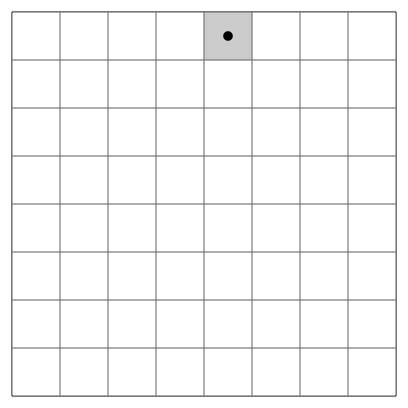I’ve written an updated version of this code here. Please take a look! It adds a visualizer, ability to solve for closed tours and step requirements, and has a better exiting strategy. 🙂
In Discrete class, we’ve been talking about planar graphs and stuff like Hamilton traversals. One of our in-class exercises involved the knight’s tour, and whether we could find a rule that would allow us to decided if a knight’s tour was possible given a chessboard of a certain dimension. I have a hard time understanding graphs, but the “Knight’s Tour” sounded really cool so I looked it up on Wikipedia. The problem is actually a pretty interesting one, so I decided to try my hand at implementing an algorithm for solving it in Python.
From Wikipedia:
A knight’s tour is a sequence of moves of a knight on a chessboard such that the knight visits every square only once. If the knight ends on a square that is one knight’s move from the beginning square (so that it could tour the board again immediately, following the same path), the tour is closed, otherwise it is open.
The .gif below is an example of what knight’s tour would look like on an 8×8 board.

In writing my own implementation, I heavily referenced this site and this site. I’ll do a walkthrough of my code below.
It makes the most sense to use a depth-first-search in our implementation, because the solution to the problem is quite far from the root since the it (the solution) has exactly M*N – 1 moves. (Where M and N are the dimensions of the board.)
I represent the chessboard as a list of lists, only because its easy that way. The position of a chessboard is indexed like so:
self.board[m][n]
Where m is the Y location and n is the X location.
During each step of the tour, the algorithm will find all of the next valid moves, and recursively run self.tour() with updated n (count), path (currently traversed points from the starting point), and to_visit (next point to visit) variables. This recursive call will continue until the function reaches a dead end where no more valid moves can be made, in which case it’ll backtrack to the last move made and try again with a different to_visit value.
An optimization was made in the form of self.sort_lonely_neighbors(), by observing the Warnsdorf’s rule heuristic. The heuristic works as follows: The knight will choose his next move by moving to a square that has the fewest next possible moves. By sorting the nodes to visit by how many possible moves are next, our knight will always traverse the graph from the edges in. This sort of logic makes sense, because it’s much easier to visit an empty square on the edge of a chessboard near the beginning of the tour without getting trapped than later on.
By default the script starts at position (0,0) on an 8×8 chessboard. However, it can be easily modified. It solved a 31×31 chessboard in less than a second, which I am mighty proud of. When I tried to go to a 50×50 chessboard, I got recursion depth exceeded errors… which I wonder if I could get around by doing something a bit more complicated than a simple recursive program. Hmm… Interesting problem for another day I guess!

This might entertain you. Now at Age 83 learning Python (to play with my grandson Age 12). In my Prior life
I have written Knight’s Tour in FORTRAN for IBM 650 (did not finish over a weekend run) and CDC 6,000
which took 8 hours and beat a Burroughs Computer which did not finish. Also wrote Knight’s Tour in EXCEL
to “prove that EXCEL ” is a computer program.
And wrote it in C to learn C code in the UNIX world.
Would like to email you the well commented intro to my C code version. It still seems faster than current stuff.
But, I need your email address.
Hi Phil,
That sounds interesting! Yes, I do prefer C when concerned with speed, because then I can leverage a lot of low level processor cheats too ;). Feel free to email me your code at hello@justsophie.com! I did know that one could get pretty ambitious when programming in Excel, but I tend to just use numpy or Matlab for most of my data processing needs haha.
Is it easy to modify this script to print out all possible solutions for one specific start posistion?
(I’m not into programming, but looking for a way to find a specific solution to a 6×6 board starting at [5,0] as a part of a quiz )
Yes. Lines 98-102 are the exit conditions for this script. If you want to find all the possible solutions, you would have to change those lines so the exit conditions check if all solutions have been found instead of just one. A warning– depending on how you implement this, it would be really easy to blow your recursion stack.
Hi!
Nice program but your print commands are missing parenthesis.
I’m using python 2.7 and kinda grew up without the parenthesis.
For python 3+ though, that’s def a thing that should be added 😛
can you tell that you developed your own algorithm or used an existing one.
Like I said in the post, I referenced solutions from other sites but ultimately wrote my own flavor of the algorithm.